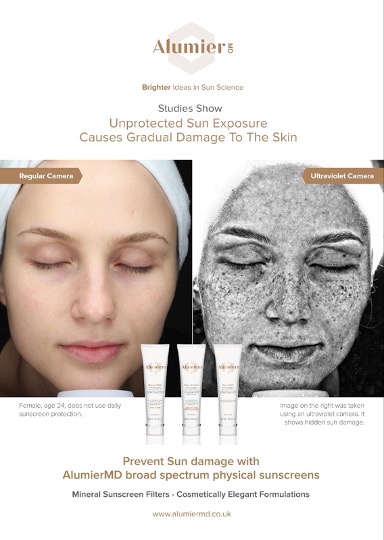Busting the Myths of SPF’s: Higher Isn’t Always Better

There are so many sunscreens available now – and they’re all labelled with lots of confusing information – so it’s easy to just reach for the one that looks like it has the highest protection. SPF 50 is higher than 30 and 40, so that’s better, right? Not always. Sorry to disrupt your brainwaves, BUT if SPF is the only thing you think about when it comes to defending your skin against the damaging impact of the sun and environment, we’re here to tell you “think wider…”
The negative effects of the sun’s rays (the degradation of skin health, advanced signs of ageing to name a few and lest we forget skin cancer) come from a multitude of rays, not just burning UVB rays. What about environmental damage? What about the full spectrum of light that comes from the sun including UVA, blue light and infrared? There’s also free radicals and pollution to consider, too.
SPF is important, but not the only thing that you need to be looking for in a sunscreen, it turns out choosing a high SPF isn’t a shortcut to total skin protection. So, let’s find out what is.
WHAT DOES “SPF” MEAN?
SPF stands for Sun Protection Factor and in short, it’s a measure of the length of time your skin can last without burning. For example, if you have very fair skin and you burn within one minute of standing in the sun, put on SPF 10 and you’ll be able to stay in the sun for 10 minutes without burning. SPF 30 minutes and so on. The difference between them is actually quite minimal let us explain. SPF 30 blocks out 96.7% of UVB radiation, SPF 40 blocks out 97.5% of UVB radiation and SPF 50 blocks 98%.
SPF IS important because UVB rays can damage skin health, but they can be blocked by clouds. They’re only around on very sunny days, making up 5% of the UV rays that reach the earth’s surface.
We refer to UVA rays as ‘stealth rays’. They travel through clouds and glass, and they’re present 365 days a year. These long light waves can penetrate through to the deep layers of skin where they can cause collagen and elastin degradation. Lines, wrinkles, discolouration… the works. FYI – A sunscreen’s SPF doesn’t measure its ability to protect against UVA, so if you’re only looking at SPF, you need to zoom out… way out.
PROTECTING AGAINST THE ENVIRONMENT
There are two main filters used in SPF products – chemical and physical. At AlumierMD, we chose to formulate with physical sunscreens only, specifically, zinc oxide and titanium dioxide because they protect against both long UVA and short UVB rays. They work, in the main, by sitting on top of the skin reflecting the light away, so it doesn’t degrade by doing its job. Therefore, once you put it on you are protected until you take it off. Ok, if you sweat or rub your skin – then yes, you do need to do a little bit of a top-up, and we’ve got a blog on that: How To Actually Reapply Sunscreen Over Make-Up.
Each of our sunscreens offers high-performance daily protection by going beyond the science of skin defence. Think power antioxidants, vitamin C and super hydration sodium hyaluronate and hyaluronic acid.
Formulating sunscreens that you WANT to wear
White coats at the ready! Let’s all imagine we’re chemists formulating with the sunscreen filters zinc oxide and titanium dioxide, there’s a lot to think about. Photostability? Frequency of application? Spectrum of protection? Zinc oxide and titanium dioxide aces them all. Plus, they are the only two sunscreen filters generally recognised as safe and effective (GRAS) certified by the FDA.
They are both thick white minerals, meaning chemists will have a job to get a high SPF that feels nice to wear, without chemicals. You’ll often see that high SPFs have a blend of physical and chemical filters. We have pushed our SPFs to SPF 40 or SPF 42 which is as high as we could get them without leaving a white cast or adding chemical filters. And we’ve done it! They feel so lightweight and comfortable, 90% of people* said their skin was more hydrated when using one of our sunscreens.
You might notice a change
Recently the European Commission announced they will only recognise SPF 30 or SPF 50 and not any SPFs in between. So that means our SPF 40 and 42 sunscreens must now say SPF 30 on the bottle, even though the percentage of protection remains the same and they will continue to be labelled SPF 40 and SPF 42 in the North Americas.
Why didn’t we upgrade to an SPF50? Because it would only offer 0.5% more protection, would be unpleasant to use if we didn’t add chemical filters and SPF only speaks to one portion of environmental protection required to protect the longevity of skin health.
So, between a basic formula with high SPF, and a hard-working hybrid sunscreen, with robust filters, that protect against all six environmental aggressors (UVB, UVA, pollution, free radicals, infrared and blue light) PLUS tippling up as your hydrating serum and foundation or tinted moisturiser… We worked incredibly hard to make the choice clear (Clear Shield?).
Primas MediSpa specialist can help you find your perfect match with personalised sunscreen recommendations for your individual skin needs.







